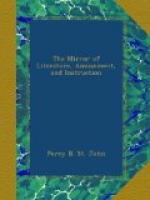The fire of London broke out on Sunday morning, September 2, 1666, O.S., and being impelled by strong winds, raged with irresistible fury nearly four days and nights; nor was it entirely mastered till the fifth morning after it began. The conflagration commenced at the house of one Farryner, a baker, in Pudding-lane, near [New] Fish-street-hill, and within ten houses of Thames-street, into which it spread within a few hours; nearly the whole of the contiguous buildings being of timber, lath, and plaster, and the whole neighbourhood presenting little else than closely confined passages and narrow alleys. The fire quickly spread, and was not to be conquered by any human means, “Then, (says a contemporary writer,) then the city did shake indeed, and the inhabitants did tremble, and flew away in great amazement from their houses, lest the flames should devour them: rattle, rattle, rattle, was the noise which the fire struck upon the ear round about, as if there had been a thousand iron chariots beating upon the stones. You might see the houses tumble, tumble, tumble, from one end of the street to the other, with a great crash, leaving the foundations open to the view of the heavens."[5]
The destructive fury of this conflagration was never, perhaps, exceeded in any part of the world, by any fire originating in accident. Within the walls, it consumed almost five-sixths of the whole city; and without the walls it cleared a space nearly as extensive as the one-sixth part left unburnt within. Scarcely a single building that came within the range of the flames was left standing. Public buildings, churches, and dwelling-houses, were alike involved in one common fate.
In the summary account of this vast devastation, given in one of the inscriptions on the Monument, and which was drawn up from the reports of the surveyors appointed after the fire, it is stated, that “The ruins of the city were 436 acres, [viz. 333 acres within the walls, and 63 in the liberties of the city;] that, of the six-and-twenty wards, it utterly destroyed fifteen, and left eight others shattered and half burnt; and that it consumed 400 streets, 13,200 dwelling-houses, 89 churches [besides chapels; 4 of] the city gates, Guildhall, many public structures, hospitals, schools, libraries, and a vast number of stately edifices.” The immense property destroyed in this dreadful time cannot be estimated at less than ten millions sterling. Amid all the confusion and multiplied dangers that arose from the fire, it does not appear that more than six persons lost their lives. Calamitous as were the immediate consequences of this dreadful fire, its remote effects have proved an incalculable blessing to subsequent generations. To this conflagration may be attributed the complete destruction of the plague, which, the year before only, swept off 68,590 persons!! To this tremendous fire we owe most of our grand public structures—the regularity and beauty of our streets—and, finally, the great salubrity and extreme cleanliness of a large part of the city of London.




